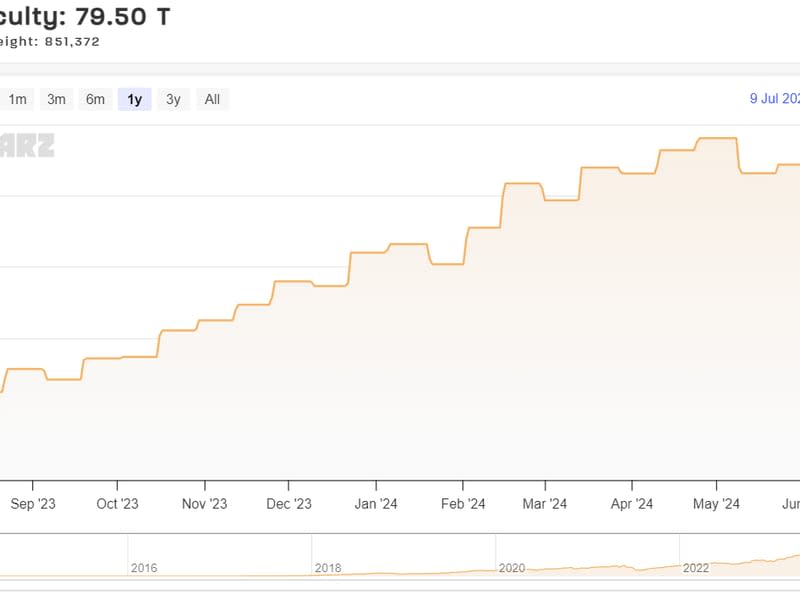Drop in Bitcoin Mining Difficulty 'Comparable to FTX Collapse,' CryptoQuant Says
Bitcoin mining difficulty dropped significantly by 7.8% on June 5, 2024, reaching levels not seen since before the halving event in April. This marks the largest difficulty drop since the collapse of crypto exchange FTX in 2022.
One analyst said miners' daily revenues have plummeted from $78 million pre-halving to $26 million currently.
This downward adjustment in mining difficulty can benefit smaller miners and potentially lead to profits for mining farms.
One of the most important participants in the Bitcoin network may have a reason to rejoice in the coming weeks as power requirements to mine blocks fell 7.8% over the weekend.
Data tracked by Coinwarz shows Bitcoin’s mining difficulty slumped from 83.6 terahash per second (TH/s) to 79.50 TH/s on June 5, reaching levels previously seen in March, a month before the halving event in April. A terahash measures how many hashes – or a digital guess for a calculation – per second a mining device, pool, or network can generate.
Mining difficulty is adjusted every two weeks and can either surge upwards or pare back. This is because of Bitcoin’s inherent structure, which keeps miners in check by checking the speed of block generation, i.e., whether they are mining too fast or too slow.
That’s one of the largest difficulty drop since crypto exchange FTX collapsed in 2022, which sent bitcoin prices spiraling down more than 10% in a week, analysts at crypto data provider CryptoQuant noted.
"Network hashrate has experienced a 7.8% drawdown, which is comparable to post FTX collapse on December 2022," CryptoQuant head of research Julio Moreno, told CoinDesk in a Telegram message. “Miners’ profitability has been hit as the daily revenues fell from $78 million pre-halving to $26 million currently.”
“Mining difficulty has been declining since early May following lower network hashrate as some miners turned off their equipment in response to lower profitability,” Moreno added.
Downward adjustments mean a proportional decrease in the network’s hashing power — or the amount of available power on the Bitcoin network. A drop can favor smaller miners and spell profits for farms that were closed due to being unable to keep up with costs.

Miners are entities that utilize extensive computing power to solve sophisticated encryptions and produce blocks on the Bitcoin blockchain. Each block rewards miners 6.25 BTC, which they typically sell to fund or expand operations.
Miners were a major source of bitcoin selling pressure in June with over $1 billion worth of BTC sold over two weeks as prices ranged between the $65,000 and $70,000 levels. Selling pressure from defunct Mt. Gox and a German government entity has since roiled markets further – with BTC dropping briefly to as low as $53,500 last week.
CoinDesk previously reported that Bitcoin hashrate and difficulty might fall during the North American summer months as miners curtail some of their operations. The lower competition may provide some reprieve to miners who are already facing a profit squeeze due to the halving event.
Meanwhile, at current prices, only a few of the most popular mining machines remain profitable for users, creating a scenario that could mark a “local bottom” for BTC.


